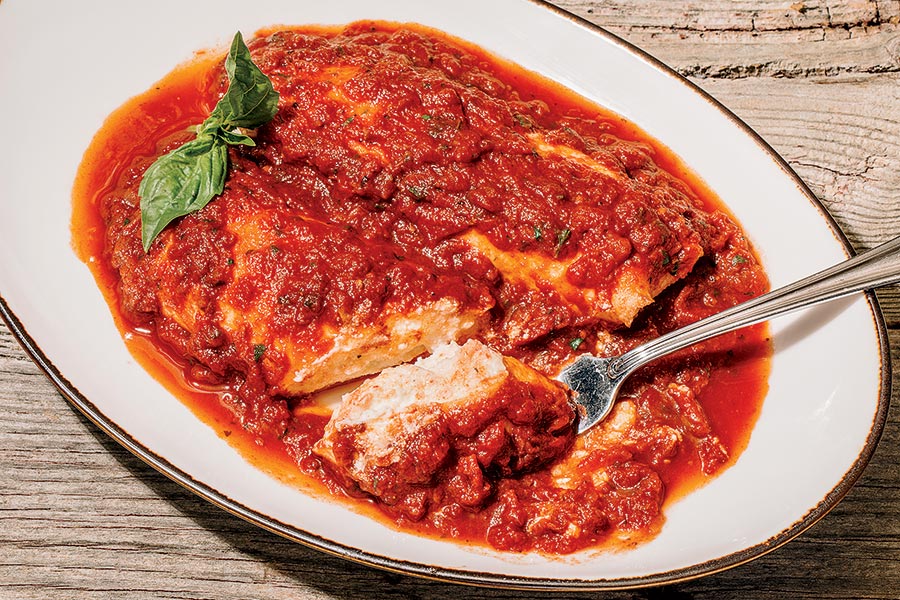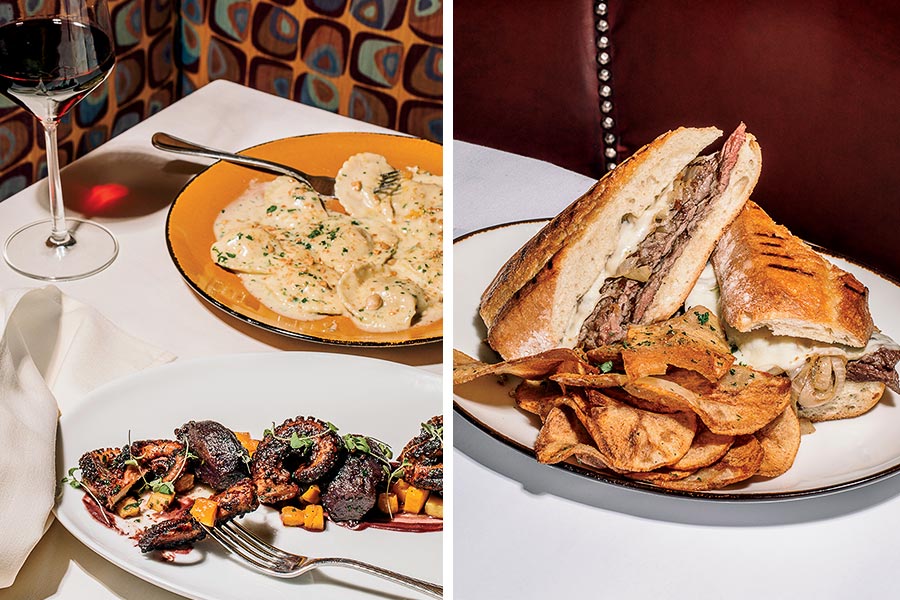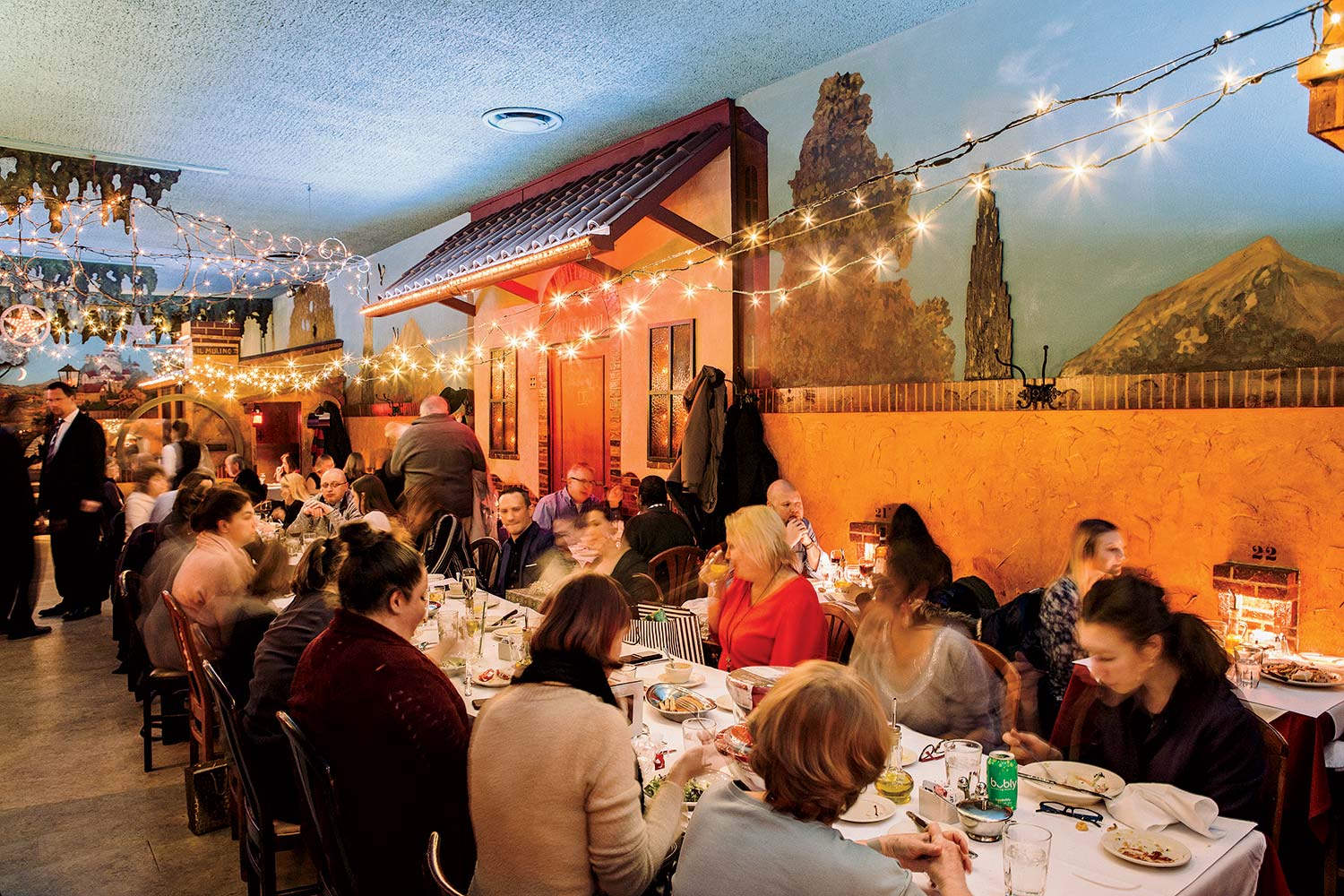On a recent weeknight, I saw a hungry couple, 60-ish and gray, wander into Italian Village, perhaps lured by the massive neon sign on West Monroe Street that seems to promise something familiar and wonderful. They paused in the vestibule and beheld three staircases and three sets of menus, confused. I can understand the feeling.
Since 1927, the Capitanini family’s citadel has exerted its gravity across downtown Chicago. Frank Sinatra once held a wedding reception in the backslappy red-sauce joint upstairs, under a Tuscan sky ceiling mural lit by hundreds of twinkling lights. In 1955, the basement became La Cantina, a snug seafood restaurant made to resemble a wine cellar. The upscale Florentine Room opened on the ground floor in 1961 and lasted 29 years before getting modernized into the glam Vivere in 1990. When people talk about the Italian Village in 2019, it’s usually as a pretheater destination, and most of the glory goes to the wine list.
But the most impressive thing about Italian Village is that it even exists. All around us, the dining rooms of old Chicago continue to shutter — Won Kow’s closure after 90 years last winter and Sabatino’s after nearly 50 in December, to name just two fallen icons. They don’t make restaurants like these anymore, albeit with good reason, given rising rents, changing tastes, and the sheer manpower required to keep a multistory juggernaut operating smoothly. So I went to Italian Village to see if it might continue to have a place in Chicago for another 92 years.

My start at La Cantina was disheartening. The packed space is cozy, with its low ceilings and wrought-iron gates. But the food, run-of-the-mill Italian chophouse fare, feels dusty and slapdash, like an assembly line meal prepared for people with a hard out at 7 p.m. The bread was stale, the fettuccine Alfredo gloppy, the rib eye lukewarm, the manicotti suffocated in sauce. The tired-looking antipasto plate — a $16 scrum of slippery mortadella, shriveled pepperoncini, and the like — felt like the kind of lowbrow platter my mom would have hastily assembled for a graduation party in 1983. And once the detached waiter learned my party didn’t have a show to get to, he lost interest and the meal ground to a halt. So did my enthusiasm.
I was much happier at the Village. The vibe upstairs is exactly like you remember it. The entryway, plastered with autographed photos of old stars like Trini Lopez and Florence Henderson, gives way to red leather booths, stucco walls, and murals of the Apennine Mountains. Everyone appears to be having a ball — the waitstaff, the crush of families and canoodlers, even Vince Masini, who has shaken bracing martinis behind the bar for more than 60 years.
Though the menu is similar to La Cantina’s, the kitchen, led by José Torres, hit the mark more often. The tomato sauce, whether atop eggplant parmigiana or a thick Italian sausage, managed to strike the sugar-acid equilibrium that eludes many pomodoros. The chicken rotolini won’t win any awards for nuance, but I’ll not soon forget the way its punchy mushroom-sherry sauce soaked into the plump breast meat rolled with prosciutto and sausage.
The restaurant may be best embodied by the prime steak sandwich: thin, wet slices of grilled beef with caramelized onions and melted mozzarella on a crusty toasted roll. No frills, all flavor. The price gouging is outrageous — unless you think $34 for a cheese-annihilated pizza with skimpy veggies and wilted basil is reasonable — but beneath the fake twinkling stars, the charm’s hard to resist.
I admit I had doubts about Vivere, the Italian Village’s oft-forgotten “contemporary” restaurant. These qualms may have stemmed from the outdated decor, all metallic curves and swirls and crimson whimsy — pure Vegas Strip circa 1990. It’s bilevel, and both levels are tragically underpopulated.

Sometimes an empty restaurant exudes the stench of indifference, and if ever there was a night for a place to sleepwalk through service, it was the frigid Monday I visited Vivere. But the flavors were tight, the service attentive, the meal well paced. Emily Phillips took over the kitchen in December and has quickly made the Capitaninis’ crown jewel relevant again. Her dishes are precise, often winkingly clever. She charcoal-grills Spanish octopus until it’s purple and tender, dresses it in port wine, and nestles it among pan-fried purple potatoes on a creamy purple garlic aïoli. The flavors bounce and snap, and it looks like something Prince would have demanded from his personal chef.
I kept waiting for the drop-off to come. It never did. Not with the pan-seared airline chicken, sliced into thick medallions and reassembled on a cannellini bean ragu with chicken leg confit and caramelized Brussels sprouts. And certainly not with the pan-seared, oven-roasted black cod fillet, which flaked off in buttery hunks between a chunky tapenade and a soft layer of red quinoa with toasted pine nuts.
That famous wine list, now curated by Jared Gelband, is too enormous to comprehend — the temperature-controlled attic holds some 30,000 bottles. But a monthly series featuring lesser-known treasures by the glass is a fine start.
Italian Village is in a good place, figuratively and literally. As long as the surrounding theater district continues to funnel in customers, the Village and La Cantina — for better or worse — will reap the benefits. I’ll be at Vivere, which could take its place among Chicago’s best Italian restaurants if Phillips is in for the long haul. But if history has shown us anything, it’s that Italian Village doesn’t need positive reviews to survive.



